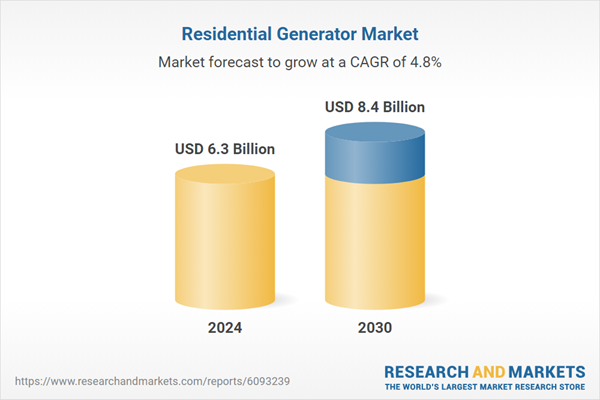Speak directly to the analyst to clarify any post sales queries you may have.
10% Free customizationThis report comes with 10% free customization, enabling you to add data that meets your specific business needs.
In addition, the surge in remote work and increased digital device usage is raising household electricity consumption, prompting more homeowners to invest in generators. Advancements in technology have made modern generators more efficient, quieter, and compatible with smart home systems. Furthermore, the desire for energy independence and rising electricity costs are pushing consumers toward backup power solutions. In some areas, government policies and incentives are also encouraging adoption of cleaner, more advanced generator systems, supporting consistent market growth.
Key Market Drivers
Rising Incidence of Power Outages and Infrastructure Vulnerabilities
The increasing frequency and severity of power disruptions globally is a major factor boosting demand for residential generators. Extreme weather events, including hurricanes, wildfires, and ice storms - intensified by climate change - have become common causes of grid failures. In countries like the U.S., outdated and overburdened electrical infrastructure contributes to these outages, while in developing economies, limited grid coverage and rising electricity demand lead to inconsistent supply.Generators offer a reliable solution for homeowners to maintain energy continuity during such interruptions. The modern reliance on electricity for communication, heating, refrigeration, and medical needs makes generators essential for maintaining safety and quality of life. These systems are especially critical in remote areas and for vulnerable populations. For example, Generac Holdings Inc. expanded its product and service portfolio by investing more than USD 800 million since 2019 in energy storage and electric vehicle charging solutions, reinforcing the strategic importance of home backup power.
Key Market Challenges
High Upfront Costs and Ongoing Maintenance Burdens
The cost of purchasing and maintaining residential generators remains a significant barrier to broader market adoption. Whole-house standby systems can range from $5,000 to over $15,000, including installation, fuel connections, and required accessories. While portable units are less expensive, they still represent a sizable investment. Beyond acquisition, regular maintenance is required to ensure generators are operational when needed.This includes oil and filter changes, inspections, and battery checks - often requiring professional servicing, which adds to the cost. Fuel expenses also vary depending on type and availability; gasoline, diesel, and propane prices can spike during emergencies, increasing operational burdens. While natural gas generators offer cost advantages, they rely on uninterrupted municipal supply, which may not be accessible in rural locations. In such areas, homeowners must also manage fuel storage, adding complexity and expense to ownership.
Key Market Trends
Integration of Smart Technology and Remote Monitoring Capabilities
A major trend in the residential generator market is the integration of smart features and IoT-enabled monitoring. These advancements allow generators to be part of the broader smart home ecosystem, enhancing ease of use and functionality. Wi-Fi and Bluetooth connectivity enable users to access real-time performance data, including fuel levels and maintenance needs, through mobile apps. Remote diagnostics, fault alerts, and automatic service scheduling minimize downtime and improve system reliability during outages. Many new models are also compatible with platforms like Amazon Alexa and Google Home, offering voice-activated controls and enhanced user convenience. These capabilities align with growing consumer expectations for connected and intelligent home technologies, making generators not only practical but also tech-savvy additions to modern households.Key Market Players
- Ashok Leyland
- Atlas Copco
- Caterpillar
- Cummins
- Deere & Company
- FG Wilson
- Generac Power Systems
- Greaves Cotton
Report Scope:
In this report, the Global Residential Generator Market has been segmented into the following categories, in addition to the industry trends which have also been detailed below:Residential Generator Market, By Power Rating:
- ≤ 75 kVA
- > 75 kVA - 375 kVA
- > 375 KVA - 750 kVA
- > 750 kVA
Residential Generator Market, By Fuel Type:
- Diesel
- Gas
- Others
Residential Generator Market, By Type:
- Stationary
- Portable
Residential Generator Market, By Region:
- North America
- United States
- Canada
- Mexico
- Europe
- Germany
- France
- United Kingdom
- Italy
- Spain
- Asia Pacific
- China
- India
- Japan
- South Korea
- Australia
- South America
- Brazil
- Colombia
- Argentina
- Middle East & Africa
- Saudi Arabia
- UAE
- South Africa
Competitive Landscape
Company Profiles: Detailed analysis of the major companies present in the Global Residential Generator Market.Available Customizations:
With the given market data, the publisher offers customizations according to a company's specific needs. The following customization options are available for the report.Company Information
- Detailed analysis and profiling of additional market players (up to five).
This product will be delivered within 1-3 business days.
Table of Contents
Companies Mentioned
- Ashok Leyland
- Atlas Copco
- Caterpillar
- Cummins
- Deere & Company
- FG Wilson
- Generac Power Systems
- Greaves Cotton
Table Information
| Report Attribute | Details |
|---|---|
| No. of Pages | 188 |
| Published | June 2025 |
| Forecast Period | 2024 - 2030 |
| Estimated Market Value ( USD | $ 6.3 Billion |
| Forecasted Market Value ( USD | $ 8.4 Billion |
| Compound Annual Growth Rate | 4.8% |
| Regions Covered | Global |
| No. of Companies Mentioned | 8 |









